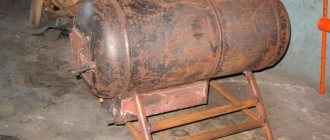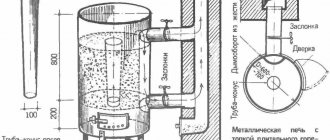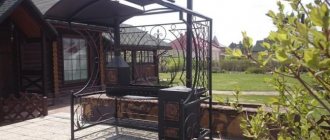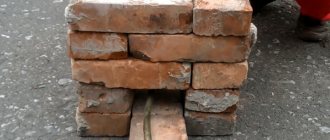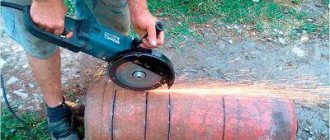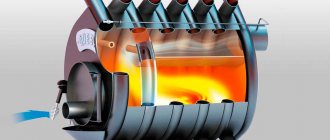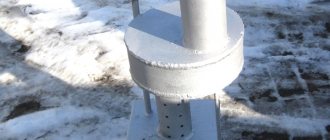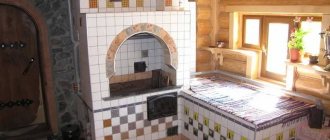Features of a long-burning stove
The first step is to understand what happens when wood burns. For a flame to appear, the temperature of the wood must be brought to approximately +150 degrees, using an external heating source. Usually, a piece of paper lit from an ordinary match is enough for this. After this, the process of slow charring of the material begins, which, after reaching +250 degrees, begins to decompose into simple chemical elements. The white smoke that appears when a flame is ignited includes gas and water vapor: they are emitted by heated wood. Ignition of the released gaseous components is observed when heating reaches +300 degrees: as a result of this, the thermochemical reaction is significantly accelerated.
The breakdown of organic matter into simple elements is called pyrolysis. Practice shows that during the combustion of wood, part of the energy potential inherent in it remains unused. This is reflected in a significant amount of waste remaining after the flame goes out. In pyrolysis furnaces, fuel is used much more efficiently, which is achieved by separate combustion of gases released during fuel combustion. At the same time, the rate of smoldering of the wood itself is very low, which helps to increase the operating time of the stove on one stack. The Bubafonya stove, which is a type of pyrolysis heater, guarantees almost complete combustion of all fuel.
We improve heat transfer
The biggest problem with potbelly stoves: inefficient heat consumption. Most of it literally flies into the chimney with flue gases. This disadvantage is effectively combated in upper combustion furnaces with afterburning of flue gases, such as the Bubafonya furnace (also, by the way, can be made from a gas cylinder) and Slobozhanka.
A variant of a potbelly stove made from propane cylinders with secondary combustion - the efficiency is higher than that of “conventional” models.
Another way to improve heat transfer is to make the chimney longer, thereby increasing the amount of heat that will remain in the room. When designing such a broken chimney, it is better to avoid horizontal sections, and even more so areas with a negative slope.
This gas cylinder stove runs on wood. We increased heat transfer by making a long broken chimney
Another option to use the heat of flue gases is to weld a vertical cylinder-smoke pipe to a horizontally located cylinder-housing. Due to the larger area, heat transfer will be higher. You just need to create good draft so that the smoke does not go into the room.
Such a potbelly stove made from a gas cylinder will warm up the room faster
You can do it the way they do in sauna stoves: put a mesh around a metal pipe and pour stones into it. They will take heat from the pipe and then release it into the room. But. Firstly, until the stones heat up, the air will warm up slowly. Secondly, not all stones are suitable, but only the round ones that are along the rivers. Moreover, they are uniformly colored without inclusions. Others cannot be filled in: they can explode from high temperatures no worse than a fragmentation shell, or emit radon, which is very harmful in significant concentrations.
The solution can be found at sauna stoves: build a grid for stones on the pipe
But this solution also has advantages: firstly, the pipe will not burn. The stones produce even heat. Secondly, after the furnace goes out, they will maintain the temperature in the room.
Often you need to quickly heat a room. To do this, you can use a regular fan that will blow through the body and/or pipe of the furnace. But the same idea can be implemented with a stationary version: weld through pipes into the potbelly stove cylinder in the upper part. On one side, attach a fan to them (heat-resistant, preferably with several speeds, so that you can regulate the temperature).
Pipes are welded into the upper part of the cylinder and pass through. On one side, a fan is attached to them, which drives air through them, quickly warming up the room.
Another option that allows you to achieve active air movement along the walls of the case and not use a fan: make a casing around the case at a distance of 2-3 cm, but not solid, but with holes at the bottom and top. Buleryan stoves or metal sauna stoves work on this principle.
One of the options for such a casing around a horizontally located cylinder is visible in the photo below. Through the gaps at the bottom, cold air located near the floor is sucked in. Passing along the hot body, it heats up and comes out from above.
This is a stove lying on its side: the casing is not solid, there are decent gaps at the bottom and top
The principle is not new, but it is no less effective. Look at the photo below to see what the finished stove looks like with such a casing.
Potbelly stove with improved convection around the body for quick heating of the room
Here is another implemented casing, around a potbelly stove made from a horizontally located cylinder
Note the non-standard door fastening
This shiny sheet improves room heating
A homemade boiler from a gas cylinder for water heating can be made using the same principle: weld a water jacket around the cylinder and connect it to the radiators. Just don’t forget that the system must have an expansion tank with a volume of 10% of the total displacement.
You now know how to make a potbelly stove from a gas cylinder and how to improve it. Watch another video about an interesting option for a combined stove for a summer house or garage made of brick and a gas cylinder.
https://youtube.com/watch?v=SMVD6li2QI4
A little history
The development of the Bubafonya stove is attributed to folk craftsman Afanasy Bubyakin from Kolyma. Subsequently, a new invention was named in his honor. During his experiments, Afanasy relied on the design of the Lithuanian-made Stropuva pyrolysis boiler.
The domestic inventor tried to simplify the design as much as possible so that it could be built with your own hands. This specificity of Bubafoni explains its high popularity. Considering that the material for the manufacture of this device is mainly improvised means, it cannot boast of external aesthetics. The strengths of the stove are its simplicity, efficiency and reliability.
Design
The Bubafonya long-burning stove includes the following components:
- Frame . The main element of the device, usually shaped like a cylinder. It is most often made from cylinders, barrels, large fire extinguishers, thick welded pipes, etc.
- Chimney through which combustion products are discharged. The material for its manufacture is usually a metal pipe with a diameter of 110-250 mm. It is fixed by welding to the upper part of the furnace.
- Piston . Ribs are welded onto the lower part of the metal circle: the air duct pipe is fixed in its central part. Due to the ribs, an additional layer of air is created that separates the fuel and the piston. This makes the smoldering process more efficient and stimulates the active release of pyrolysis gases.
- Regulator . Thanks to this valve, oxygen is supplied inside the firebox.
- Lid . It has holes for the air duct, forming, in combination with the piston, a secondary combustion chamber. Inside this compartment combustion of pyrolysis gases occurs.
Selection principles
When choosing, you need to consider a number of factors:
Oven dimensions. Its dimensions should not interfere with free movement around the bath premises
It is recommended to choose a design with an external combustion chamber. Fuel consumption. If there is no warm water in the bathhouse, you need to choose a model with a water tank. If you want to buy a universal model, it is recommended to pay attention to units powered by gas or solid fuel. A special mechanism is installed inside the structure, which divides the combustion chamber into two parts for different types of fuel.
The volume of the water tank depends on its location. If it is built-in, the capacity will be small. If it is external, the volume will be greater.
Selection of oven
Advantages and disadvantages
Advantages:
- Small size. The design does not have a large combustion chamber as in stoves that run on solid fuel.
- Furnace equipment allows you to set different temperature conditions. Thanks to this, you can set the optimal temperature and maintain it for a long time.
- If you don’t need to heat the sauna, you can simply heat the water in a mounted or built-in tank.
- Fast heating.
- You can connect gas cylinders if it is impossible to connect a pipe with a central gas supply.
- Fuel efficiency.
- Universal models can use 2–3 types of fuel.
Flaws:
- The risk of explosion is higher than that of equipment operating on other types of fuel.
- It is necessary to constantly change gas cylinders or connect the stove to the central gas supply system.
If there are no problems with the gas supply, there are fewer disadvantages.
Popular models and prices
Popular models:
- Furnace "P-20GT". Power - 20 kW. Suitable for heating steam rooms with a volume of up to 22 m3. There are fastenings for installing a water tank.
- KUTKIN Standard G-2.0. Model for heating rooms up to 16 m3.
- Termofor Taimyr INOX. Suitable for heating steam rooms with a volume of up to 18 m3. The design has two heaters - internal and external.
- Termofor Urengoy Carbon. Made from high strength steel. Suitable for heating rooms up to 12 m3.
- Heat-Malyutkagaz. Equipment power - 16 kW. Designed for heating steam rooms with a volume of up to 12 m3.
The average price of gas stoves is 16,000 rubles.
Types of furnaces
Strengths and weaknesses of Bubafoni
The pyrolysis stove has a number of positive qualities:
- Simplicity of design . Having welding skills and experience working with metal, building a stove will not be difficult.
- Universalism . Bubafonya is very unpretentious in terms of fuel: you can throw firewood, coal, sawdust, chips and other types of wood waste into it. The stove also copes well with pellets – inexpensive, environmentally friendly granules.
- Duration of work . The time it takes for one stack of firewood to burn out is almost a day: during this time, the stove regularly generates heat. This indicator may vary depending on the modification of the device, the volume of its firebox, the oxygen circulation rate, etc.
It is also worth mentioning the main disadvantages of Bubafoni:
- Low efficiency . The reason for this is uneven heating of the device body with sufficiently low heat transfer. More “advanced” pyrolysis furnaces are much more efficient in this regard: their efficiency often exceeds 90%.
- Inconvenient to clean . There is no ash pan as such in the design, so the remaining combustion products are removed through the top. Some modifications of the stove are equipped with a door at the bottom, which facilitates the procedure for removing ash and ash.
- Low aesthetics . The appearance of Bubafoni can hardly be called beautiful, so it is mainly used for heating utility rooms.
Work principles
A DIY gas cylinder sauna stove generates heat due to the following elements:
- Blower is a channel at the bottom of the structure through which air is pumped. It provides sufficient oxygen for combustion and collects ash. The blower is equipped with a door that regulates the power of the furnace, increasing or decreasing the amount of incoming air;
- The firebox is the combustion chamber and the main source of heat. It is located at the top of the oven. Between it and the ash pit there is a grate on which firewood or coal is placed;
- A chimney is a channel for removing combustion products outside the room. It can be partially closed (using a wedge gate) to slow down fuel combustion and increase furnace efficiency.
Each of the elements described above takes part in the operation of a homemade sauna stove. The blower allows air into the firebox, creating favorable conditions for burning fuel. Wood or coal burns in the firebox, producing heat. This process is accompanied by the release of carbon monoxide and other components that are removed from the room through the chimney.
Using a throttle valve and a wedge-shaped solution, the power of the furnace is regulated. Well, the door in the firebox is used to load fuel and remove ash.
Drawing up a drawing
The main proportion in the process of making a homemade Bubafonya stove from a gas cylinder is the mathematical ratio of the parameter of the internal diameter of the body and its height. It should be between three and five to one. The optimal diameter is from 30 to 80 cm.
Making the diameter of the stove body less than 30 cm is not effective, since oxygen will circulate too quickly through the combustion chamber without fully reacting with the wood. This leads to a noticeable decrease in the efficiency of the device. In chambers with a diameter of more than 80 cm, another problem arises - in it, the firewood on the edge burns very slowly, and in the center - faster. As the fuel burns out, a hole appears into which the piston descends. As a result, the flame gradually fades away. In the drawing, it is more convenient to denote the diameter by the letter D, and the height by H.
Ways to improve heat transfer from a propane cylinder stove
You can even sleep comfortably in the forest! dry pipe system: do-it-yourself “stove” for a tent
As mentioned above, the main disadvantage of a garage stove made from a gas cylinder is its poor thermal efficiency, because... a significant part of the heat obtained during combustion simply goes out through the chimney along with the gases.
There are several ways to improve the heat transfer of a homemade stove:
- Apply afterburning of flue gases. In this case, the design of the potbelly stove will resemble a “bubafonya” or “slobozhanka” stove. This will make it possible to increase the efficiency of the device by an order of magnitude.
- Extend the chimney pipe. In this case, part of the heat that goes outside remains inside the room. To do this, the pipe is given a broken configuration, without horizontal sections and negative angles.
- Use a smoke pipe. Another cylinder in a vertical position is welded onto the horizontally located stove body from a wood-burning gas cylinder: it will act as a smoke pipe. Improved heat transfer of the stove is achieved here by increasing the area of the heating surface. The condition for preventing smoke from entering the room is the presence of good draft.
- Arrangement of the heater. This technique is widely used in baths, where rubble is used for additional heat accumulation. The metal chimney is equipped with a mesh into which stones are poured to take heat from the pipe and transfer it to the room. In this case, it will take some time to warm up the stones: before this, the air will heat up with some slowdown. But in the future, the surface of the pipe will not burn, and the heated stones will evenly heat the surrounding space. Even after the wood burns out, the accumulated heat will continue to maintain a comfortable temperature in the room for some time.
When selecting stones for backfilling, it is recommended to give preference to round river samples: it is desirable that they have a uniform color without any inclusions. Other types of stones can even be dangerous, bursting when heated, or releasing substances harmful to health.
Piston pressing block
The distance from the piston to the inner surface of the piston is calculated using the formula 0.5xD. To calculate the diameter of the pancake, accordingly, the formula d = D – 2xH is used. Calculating the height of the pressing ribs from a metal profile is more difficult, because The relationship between the parameter values is nonlinear. Theoretically, for a furnace body with a diameter of 60-80 cm, this parameter is taken as a number of 0.1xD. The Bubafonya stove from a smaller gas cylinder is calculated using a proportional equation, taking into account that with D0 = 30 cm h0 = 4 cm.
Preparation stage
To be used as a housing for a furnace, the cylinder must meet the following number of parameters:
- The cylinder must be all-metal; composite materials are not suitable - they are not heat-resistant and are quite explosive;
- The volume of the gas cylinder must be at least 12 liters. Stoves made from smaller volume cylinders are not economical due to the low ratio of volume to surface area. The fuel in such a stove will not burn completely due to high heat loss. Cylinders with a volume of 12 to 27 liters are suitable for the manufacture of small stoves for heating small rooms from time to time. The most suitable volume of a gas cylinder is 50 liters. Stoves of this size are suitable for long-term operation and use any fuel efficiently;
Industrial pneumatic cylinders (the common size is 40 liters, smaller sizes are used for helium) are not suitable for converting them into any heating devices using household means. They have very thick walls, and they themselves are heavy and bulky; their shape is not suitable for use as a firebox - they are too elongated in length.
Pancake thickness
This value is in inverse proportion to the internal diameter D. It is necessary to achieve optimal piston pressure on the fuel filler. If the pressure is insufficient, this will lead to a decrease in the reverse action coefficient. As a result, the firebox may backfire with further smoke escaping through the chimney. If the piston is very heavy, this will significantly reduce the air gap necessary for high-quality combustion: as a result, the flame will die out.
The relationship between the internal diameter and thickness of the pancakes is approximately as follows:
- 30 cm – 6-10 mm.
- 40 cm – 6-8 mm.
- 60 cm – 4-6 mm.
- 80 cm – 2.5-4 mm.
Fireplace for gas heating at home
In terms of equipment costs, gas fireplaces are comparable to their electric or wood-burning counterparts. But gas fuel is much cheaper.
And, unlike firewood, gas heating using a fireplace in a country house means there are no problems with ash. Plus, you don’t have to constantly monitor the operation of the firebox and worry about chopping logs.
Fireplaces that convert gas into thermal energy are used in heating systems because... are not equipped with the devices necessary to service two circuits
According to the type of installation, gas fireplaces are:
- wall;
- island;
- built-in
In terms of their general design and internal contents (burners, automation, design of combustion chambers), they completely replicate gas boilers. In both cases, the technology for connecting to networks is identical. Differences exist only in the principle of heating the premises.
According to the principle of connecting and organizing the heating system, gas fireplaces are similar to floor-standing heating boilers
A hot water boiler is initially designed to heat water, and a regular fireplace is designed to convect air from the body and front screen, behind which fuel combustion occurs.
Calculation of the optimal chimney area
When determining the smallest permissible area S, the pipes are based on the maximum energy release per hour. S(cm2) = 1.75 x E (kW/hour). Here E = m x q where m is the weight of one portion of fuel: it is calculated by multiplying the maximum volume of the load V by its density. The coefficient q denotes the specific energy of combustion of a unit volume of fuel in 1 hour.
How to calculate the consumption of natural and liquefied gas
The main indicator on which the calculation depends is the area of the room and the power consumption of the equipment. Outdoor temperature readings taken during the coldest time are also taken into account.
The calculated figure is ideally always 35-50% higher than actually consumed, since the air temperature always changes up or down. When choosing ready-made equipment, this fact should be taken into account and instead of, for example, 100 W of energy, you can take 50.
The amount of natural gas is calculated using the formula: L = Q / (qH x 0.92), where:
- L – calculated volume of fuel (1 cubic meter per hour);
- Q – heating power, kW;
- qН – maximum fuel combustion power, for natural gas 10.175 kW/m3;
- 0.92 – efficiency of a gas boiler/furnace.
On average, for heating a room with an area of 100 sq.m. the calculation will look like this: 5 / (10.175 x 0.92) = 0.53 m3 / h, which corresponds to the consumption of natural gas per unit of time (hour).
Based on such indicators, it is possible to determine the nominal gas consumption in any room for a certain period of time. Since the bathhouse is not used daily or around the clock, this consumption will be less.
Bottled (liquefied) gas is more expensive and its consumption will have to be calculated not by liters, like natural gas, but by kilograms. The heat of combustion of gas remains the same - 10.175 kW/m3 = 12.8 kW/kg, heating power - 5. We get: 5 / (12.8 x 0.92) = 0.42 kg/h, which corresponds to 0.78 liters per hour. Considering that 1 liter of bottled gas weighs 540 mg. Based on the approximate number of days and hours of operation of the bath, you can calculate the required volume.
In order to make a stove for a gas bath with your own hands, you need to decide on three main parameters:
- Material;
- What kind of gas burner will it be?
- Placement of the container – built-in or remote tank.
Now about each of them in more detail.
Preparatory activities
Since constructing a Bubafonya stove from a gas cylinder will require a welding machine, it is necessary to find a suitable room for the work in advance. It must be equipped with effective ventilation, uninterrupted power supply and reliable wiring (as a rule, the use of welding provokes power surges in the network). The workroom must be well protected from climatic influences and have sufficient space. It is also desirable to have good sound insulation, since the grinder and welding machine are quite noisy tools.
You also need to prepare the following materials:
- Old gas cylinder. This is the basis for a pyrolysis oven. Also suitable for this role is a steel or cast iron barrel with a volume of approximately 200 liters, which has strong, rust-free walls. Often, large fire extinguishers or metal pipes with welded bottoms are used for this.
- Pieces of reinforcement. They will be needed to make handles, which are usually installed on the sides of the case and on top of the lid. This significantly simplifies the procedure for cleaning the stove from combustion residues and moving it from place to place.
- Steel sheet for piston.
- A pair of metal pipes. They are needed for the manufacture of a chimney and air duct. The optimal cross-section for the air pipe is 85-100 mm. Moreover, it is approximately 150 mm higher than the height of the cylinder. For the chimney you will need a wider pipe: its diameter must be at least 150 mm. The length of the smoke channel should not be less than the cross section of the cylinder.
- Channel.
- Material for laying the foundation for the stove.
List of tools required for work:
- Hammer.
- Vise.
- Shovel.
- Master OK.
- Portable welding machine with a set of electrodes.
- Grinder for cutting blanks.
- Tape measure, pencil, plumb line and level.
The process of making a stove from a gas cylinder (Option 1)
Do-it-yourself stove for a bathhouse: step-by-step instructions with expert recommendations
If you have noticed an ownerless cylinder in your household, and there is nowhere to use it, nevertheless, the heating agent is so necessary, then with a little “magic”, the cylinder can be turned into a stove. The stove will be like a potbelly stove, with a smooth chimney and without a developed area on the walls, like a Breneran. This means that the efficiency of the stove is not high, but this is a very good option for a small country house or for use in a garage. At least the costs for such a stove are minimal, and production is not so problematic, as you will see by reporting now. So, we take a cylinder and, first of all, get rid of explosive gases. It is best to unscrew the valve with a gas wrench and then fill the cylinder with water. Afterwards, you can drain the water and begin mechanical processing of the cylinder. We cut a hole at one end for the door. It is better to first purchase the door on the market (in a store) in order to know what size to cut the cylinder to.
Now on the opposite side you need to make a hole for the chimney or, more simply, for the pipe. In order to contain the heat at least a little, after the stove is heated, it is necessary to introduce a damper. There is also no point in making such a damper yourself; it is easier to find it in trade structures. So, in the end opposite to the door, we cut a hole for the damper in the pipe. Since the shape is a circle, it would be best to first drill a hole for installing a jigsaw, and then using a special blade for metal, cut out this very sphere from the end of the cylinder.
We weld the door. If the door is made of cast iron, then the metals must first be heated. In a heated state, high-carbon alloys can be welded with an ordinary welding machine.
Now you can weld the pipe with the damper.
Now there is very little left. Initially, you need to think about the fact that the stove should stand above the supporting surface. It is better to finally implement this using rods by welding its legs. In order for the firewood to burn better, and also to prevent ash and embers from interfering with the combustion process, it is necessary to provide gaps through which the combustion food would spill out of the wood burning chamber. It is necessary to place a tray under these cracks, into which the ashes will be poured.
Now all that remains is to install the chimney pipe, connecting the elbows together, fortunately this is not a problem now. Chimney fittings are sold in a variety of sizes and shapes. Afterwards you can begin the actual process of operation. As we have already said, the heat capacity of this stove cannot be compared with the “Russian” stove, but its advantages are its small size, quick heating and the ability to make it from a gas cylinder without any problems, with your own hands.
How to assemble a structure with a water jacket
The manufacture of the chimney is carried out in the following sequence of operations:
- Carefully cut the balloon at the top. The resulting cap is subsequently used to make a lid for the boiler.
- The bottom of the cylinder is equipped with homemade legs. Each of them must be exactly level before fixing.
The piston is constructed in three stages:
- A steel circle is cut out: in cross section it should be approximately 35-45 mm smaller than the internal diameter of the cylinder. Thanks to the side gaps, pyrolysis gases will leak into the secondary chamber without interference. A hole is made in the center of the circle for the air duct: this pipe should be inserted into it quite tightly.
- Next, the metal circle and pipe are welded to each other.
- A piece of channel is welded on top of the piston base.
To make a furnace lid, you can use the upper cut part of the cylinder. On its surface, markings are applied for the air duct pipe with a fixed supply piston. In this case, it is necessary to provide a certain margin for the free movement of the pipe. Cutting is done along the drawn lines. On the side, the homemade lid is decorated with handles, for which fittings bent in a vice are used. Now you can begin installing the chimney at the top of the improvised pyrolysis oven. Using a grinder, a cutout is made for the pipe blank: welding is also used to fasten the parts.
To increase the quality of chimney draft, it is recommended to make it from two elbows perpendicular to each other. To do this, a cut is made at the end of the pipe section leaving the furnace at an angle of 45 degrees, after which it is connected by welding to a piece of pipe of the same diameter. It would not be superfluous to take care of additional protection for the chimney from the ingress of debris and climatic precipitation - a reflective cap is usually made for these purposes.
At this point, the main part of the work on the construction of Bubafoni is considered completed: it can be put into operation. It is advisable to install the stove on a pre-arranged foundation.
Independent arrangement from disks
If you are familiar with the technique of working with a welding machine, you can consider the option of creating a sauna stove from disks from a truck. To do this you need to prepare:
- Four rims from truck wheels;
- Metal sheets with a thickness of at least 5 mm;
- Brick, preferably fireproof;
- Clay mortar;
- Cement;
- Metal rods;
- Chimney pipe.
To install the most functional disk sauna stove, you need to find four unnecessary rims from a truck. Each of them plays a role:
- The first disk is a cap for the combustion chamber;
- The second plays the role of a heater;
- The third disk is a heat exchanger that transfers heat to the steam room;
- The fourth disk will serve as a tank for water in which it will be heated.
Assembly steps
- Let's start with the water tank. To do this, two rims are fastened together by welding. It is also necessary to prepare a bottom of the same diameter as the rim and attach it to the bottom of the resulting structure. You need to cut a hole in the bottom for the pipe. The water tap is mounted on the side of the rim. The finished structure must be covered with a metal lid;
- You should not rush to place the water tank in the bathhouse, since first you need to check its tightness. To do this, the tank is filled with water and checked for leaks. If there are any, the water from the tank must be drained and the cracks removed using a welding machine. Only after this the finished tank is installed in the bathhouse;
- Next, the heater and firebox are installed. To do this, two car wheels are welded together. A metal mesh is installed in the middle of the resulting cylinder, on which stones are subsequently placed.
They started using car scraps to make stoves not so long ago, but this type of homemade product is quickly spreading. The material is practically waste, the metal is good, there are different sizes, you can build a unit of any power. For this furnace, disks from ZIL-160 were used. They have ideal dimensions - height 250 mm, diameter 500 mm, and metal thickness - 7 mm.
The stove requires 4 discs and solid ceramic bricks (about 60 pieces). It’s better than stove-made, but you can also use regular one, the main thing is good quality. To remove smoke, you will need two steel pipes with a diameter of 160 mm, a length of 50-60 cm, and a wall thickness of 5-6 mm. The bottom of three disks is welded and the holes are welded (with metal plates at least 5 mm thick).
This furnace requires a separate foundation (the construction of the foundation for the furnace is described here) - the mass turns out to be substantial. In the figure, the foundation is deliberately made below floor level so that part of the ash pit is in the underground. This promotes good ventilation and dries the boards after procedures.
The lower part folds into half a brick. Its dimensions are 625*265 mm. The ash door, grate, and firewood storage door are installed.
Sauna stove made of wheels and bricks
We take a disk without a bottom. We weld a circle with a diameter of 380 mm from metal 5 mm thick to it on rods. If possible, it is better to make it concave. This is a divider that forces smoke to move along a complex trajectory, improving heat removal.
We weld a divider on one of the disks without a bottom
We install the disk with the divider on the brick body of the furnace. We take the disk, place it bottom down on the installed one, and weld them in a circle. We cut a hole in the center of the bottom and weld the pipe. This is a heater. To it, using legs (4-6 pieces) made from reinforcement with a diameter of 12-60 mm and a length of 200 mm, we attach another disk with a bottom. If you want a closed heater, make a removable lid. You need to give it some steam - they opened it, poured water, then closed it again.
It also requires making a hole in the center and welding an adapter casing into it, into which the chimney is inserted (the node is circled in red in the figure). This casing is slightly larger than the outer diameter of the pipe. The remaining gap during assembly can be filled with asbestos cord and filled with clay mortar, on which the brick bottom of the stove was placed.
The middle part of a sauna stove made from car rims
Next we cook another divider. This is a bowl, the diameter of which is 30-60 mm less than the diameter of the disk, the height of the sides is 50-60 mm. We make the bowl from metal with a thickness of at least 4 mm. We install the divider inside the third disk on legs made of the same reinforcement, 50 mm high (quantity - 3-5 pieces).
The fourth disk is used as a tank for heating water (volume 40 l). If you heat it in another way, you can put stones here or do without it altogether.
This disk must also have a sealed bottom with a chimney welded in the center. At the bottom we weld a fitting for draining water. We make a lid at the top. it can be made of metal with a thickness of 2 mm. It is convenient if the lid consists of two halves.
Tank for heating water and passage through the ceiling
This tank does not need to be welded. An asbestos cord soaked in clay can be laid along the edge of the lower wheel rim. Place a little clay mortar on top, place the resulting tank and press down.
The last thing is the ceiling cutting. You can place a sandwich pipe, a gate valve and a standard or homemade passage unit above it, or you can make a cutting out of brick.
And this is what a ready-made sauna stove made from rims and bricks looks like
To support the cutting, a metal platform is attached to the pipe; it is additionally fixed with legs. The cutting itself is laid in one and a half bricks, has 5-6 rows, the cross-section of the smoke channel is square. A stove valve is installed between the first and second rows (the bricks are trimmed). The upper part of the chimney can be made of a sandwich, you can install an asbestos pipe, or you can use a metal pipe, but it will need to be wrapped in heat-resistant heat-insulating materials (to prevent condensation from falling out). Just pay attention, the total mass of the chimney should not exceed 50 kg - this is the maximum load that the structure can withstand.
Foundation construction
The foundation for the Bubafonya stove is laid in this way:
- The first step is to dig a square hole. Its approximate dimensions are 150x150 cm, with a depth of 20-30 cm.
- The bottom of the trench is covered with a cushion of crushed stone and filled with concrete solution. A trowel is useful to level its surface. When the filled area has set, it is necessary to check the horizontalness of its surface using a building level. If necessary, additional adjustments are made.
- Refractory bricks are laid in several rows on top of a completely dry concrete base. Usually 2-3 layers are enough.
Oven operation
Before igniting the Bubafoni, it is necessary to remove the welded air duct from inside the housing, first removing the top cap. Wood logs are placed inside the stove in a horizontal position, close to each other. When stacking vertically, some obstacles may arise in the path of the piston movement: this usually happens in cases where the logs are not completely burned. As a result, smoldering in the primary chamber will develop into full-fledged combustion, which seriously impairs the proper functioning of the stove. In this case, firewood is consumed much faster, and smoke begins to seep out of the air duct. When laying logs, it is prohibited to block the area where the chimney is welded.
A layer of chips, sawdust or chopped branches is poured onto the firewood. On top of them you need to put old cloth or paper soaked in kerosene. A piston is installed end-to-end on the fuel filler and a cap is put on. To light firewood, you need to light a piece of rags or paper and throw it inside through the air pipe. Matches are ineffective in this case, since they go out before they can reach the fuel. After lighting the firewood, pause for 15-20 minutes, allowing it to flare up well. When the flame gains strength, the valve on the air pipe should be closed: thus, Bubafonya is transferred to the main operating mode.
Will a small bottle suffice?
Features, specifics of use and manufacture of the poshekhonka stove
You can also work with a small balloon. It is made according to the same plan as a horizontal stove.
But in this version, instead of drilled holes in the bottom of the stove, a cast iron grate is installed. A window of the required size was cut out for it.
Installation of a cast iron grate
The blower in combination with the grate is welded as follows.
Ash pan made from a piece of channel
- Next, the legs are welded onto the ash pan box, the structure is turned over and the chimney pipe is installed on top and secured by welding.
- After completing work on the potbelly stove, it is installed in a permanent place and the chimney is taken out into the street.
